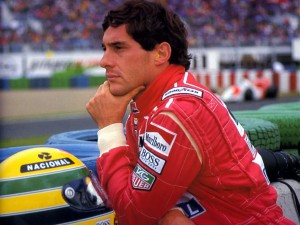SENNA – Man, machine and mastery

Ayrton Senna
![]()
Senna – Asif Kapadia
A moving homage to one of the greats of Formula One. Nominated as one of the greatest racing drivers of all time by the most discerning judges, his fellow drivers, Ayrton Senna da Silva was 3-times World champion in 1988, 1990, 1991. His death in the San Marino Grand Prix on Sunday 1st May 1994 turned an extraordinary sportsman into a legend.
Kapadia’s film is a faithful if somewhat routine biography distinguished more by the editing of plentiful footage of Senna’s racing career, spliced with much evocative private family material, than any distinctive perspective on the man or the sport for which he had such a palpable passion. Despite the hype and publicity there is little here that one could not expect from a sympathetic BBC or Sky sports biography. Racing fans will be more than satisfied and are not short-changed by this traditionally structured film: taking us from Senna’s early success in go-karting and gradual progress to F1 racing; displaying apart from a natural driving talent a particular instinct for coping with bad weather, especially the rain. Adverse conditions tend to level off technological advantage, so often the decisive factor in Formula 1, leaving more to the instinct and natural skill of the driver himself. This probably explains in part, the regard for his driving skill displayed by his driver peers.
In politically turbulent years in his native Brazil, with enormous social disparities between rich and poor, Senna’s domination of world motor racing at the end of the 90’s accorded him an almost saint-like status to the Brazilian people at all levels. His effortless good looks, obvious intellect, natural charm and air of danger derived from his passion for speed and F1 success, turned a slightly gawky, uncertain teenager into the self-assured quiet eye of the chaotic hurricane of politics, big business and worldwide brand that was and still is Formula One Racing.
For F1 fans therefore no complaints. And yet and yet: none of the many contradictions and conflicts of this unusually articulate and thoughtful sportsman are dealt with or addressed with anything like the determination, honesty or courage with which it appears he approached the sport that was the passion of his life and the tragic trajectory of his violent death. Senna’s life and career raised many questions, which are largely glossed or ignored in Kapadia’s overly reverential treatment. The quality of the man was quite robust enough to withstand a more rigorous examination and would have been a more fitting tribute than this sometimes bland biopic.
The bitter feud between Senna and Alain Prost who he replaced as world champion is covered but not explored; his unusually high collision record is referred to in a fascinatingly tense interview by Jackie Stewart but not developed or commented upon; his battles with a French dominated, highly political F1 hierarchy receive no real analysis; and the deepening importance of his Catholic faith to his life is merely mentioned. Senna’s crash was the 3rd in as many days at San Marino: Rubens Barrichello was lucky to survive a horrifying accident in practice on the Friday of the racing weekend; then Roland Ratzenberger was killed on the Saturday before Senna’s fatal crash the following day. Mention is made of the fact that 1994 was the first year when computerised tracking and road-holding technology had been banned to minimise technological dominance and reputedly had made the cars less predictable and stable. We are told Senna was unhappy with his car and had reservations about driving at all. All of these issues are left hanging tantalisingly and frustratingly in the air.
A more rigorous treatment in the film would not have required a sensationalist or mud-slinging approach. But the man and the issues deserved a more incisive Director than Kapadia. Perhaps access to the private footage and willing cooperation of other interested parties, especially the F1 hierarchy, imposed limitations. If so, then the lessons of Senna the man and Senna the totally committed driver, have been done a disservice. As an outsider I cannot be sure of this but I do feel disappointed that this fascinating man who did remarkable things is not much better known to us after this film than before it. For me therefore an opportunity missed: and perhaps for the wrong reasons.
In the end perhaps the most fitting legacy to which Senna’s technically unlikely death on a fast but uncomplicated bend contributed, is that thanks to improvements to safety led by his personal friend and doctor, Professor Sid Watkins, there has been no fatality in Formula 1 racing since that fateful day in Italy on the 1st of May 1994 when an extraordinary, tragically young man, left the sporting arena he had dominated and graced so completely for a few short years. We honour our heroes in our remembrance, not their longevity. For that reason alone Senna is well worth a visit
Filed under: 3 star, Documentary, General

